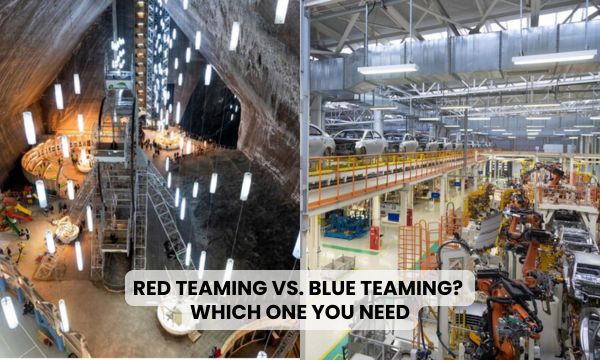
As cyber threats become more sophisticated, relying on one-dimensional security measures is no longer enough. Organizations need a balanced, proactive, and reactive defence strategy to safeguard their infrastructure. This is where Red Teaming and Blue Teaming come into play.
In this blog, we will break down the differences between Red Teaming and Blue Teaming, explain how they complement each other, and explore why industries like mining and manufacturing—which manage critical infrastructure—must integrate both strategies for comprehensive security.
What Is Red Teaming?
Red Teaming involves an external group of ethical hackers simulating real-world attacks to test an organization’s defences. The Red Team operates like a malicious actor, attempting to bypass security measures and exploit vulnerabilities, revealing weak points in the organization's infrastructure, applications, and networks.
Key goals of Red Teaming include:
* Simulating sophisticated attacks: Red Team exercises replicate tactics used by advanced cybercriminals or nation-state actors.
* Identifying gaps in detection and response: Red Teams assess how well an organization’s defences can detect and respond to real-world attack scenarios.
* Testing incident response protocols: Red Team exercises push the organization to react in real time, helping to refine response strategies and improve overall resilience.
What Is Blue Teaming?
In contrast to Red Teaming, Blue Teaming focuses on the defensive side of security. The Blue Team is responsible for detecting, preventing, and responding to security incidents. While Red Teams are the “attackers,” Blue Teams are the “defenders” who work to secure the organization's network, systems, and data.
Key functions of Blue Teaming include:
* Monitoring and detection: The Blue Team constantly monitors for signs of intrusion or malicious activity, using tools like intrusion detection systems (IDS) and security information and event management (SIEM) solutions.
* Incident response: When a threat is detected, the Blue Team takes action to contain and remediate the attack, minimizing damage.
* System hardening: Blue Teams work to strengthen security measures, such as patching vulnerabilities, configuring firewalls, and enforcing best practices to reduce the attack surface.
Red Team vs. Blue Team: Key Differences
|
Aspect |
Red Team |
Blue Team |
|
Objective |
Simulate real-world attacks to find vulnerabilities |
Defend against attacks, detect, and respond |
|
Perspective |
Offense (external) |
Defence (internal) |
|
Focus |
Breaking in, exploiting weaknesses |
Securing, monitoring, and responding |
|
Tools and Tactics |
Uses penetration testing, social engineering, phishing |
Uses firewalls, SIEM, IDS/IPS, and endpoint security |
|
Outcome |
Identifies vulnerabilities and areas for improvement |
Strengthens defensive measures and incident response |
Why Mining and Manufacturing Need Both Red and Blue Teams
1. Critical Infrastructure and High-Stakes Operations
Industries like mining and manufacturing operate critical infrastructure where security breaches can have catastrophic consequences. A successful cyberattack could result in operational downtime, damage to industrial control systems (ICS), and massive financial losses. Worse, it could potentially lead to safety hazards for employees.
Red Teaming provides insights into how attackers might infiltrate industrial systems, while Blue Teaming ensures proper monitoring, detection, and response measures are in place to counter any detected threats.
2. Proactive and Reactive Defense
Having both Red and Blue Teams allows these industries to develop a holistic security strategy. The Red Team identifies weaknesses that need to be addressed, and the Blue Team works on fortifying defences and improving incident response. This cycle of continuous improvement ensures both proactive measures (finding and fixing vulnerabilities) and reactive measures (responding to incidents) are aligned for optimal protection.
3. Addressing Sophisticated Threats
As industries that rely heavily on automation and specialized equipment, mining and manufacturing are increasingly targeted by Advanced Persistent Threats (APTs), state-sponsored groups, and other sophisticated adversaries. Red Team exercises allow organizations to understand how these high-level attackers might gain access to critical systems.
Meanwhile, Blue Teams ensure that if an attack begins to unfold, they can detect it quickly, contain it, and recover from the damage efficiently. This is especially important when dealing with industrial networks or supervisory control and data acquisition (SCADA) systems, where downtime can have significant consequences.
4. Regulatory Compliance
Both mining and manufacturing industries are subject to specific regulatory requirements around data protection, operational continuity, and employee safety. For example, certain compliance standards require regular security assessments, testing, and system hardening. Red Team exercises can reveal whether your defences meet these regulatory requirements, while Blue Team efforts focus on ongoing compliance and security posture improvement.
How Red and Blue Team Collaboration Creates a Stronger Defense
The most effective cybersecurity strategies involve collaboration between Red and Blue Teams, sometimes referred to as Purple Teaming. In this approach:
* Red Teams continuously test and assess the defences by attempting to exploit vulnerabilities.
* Blue Teams monitor these exercises and fine-tune their defences based on the tactics used by the Red Team.
- The two teams share knowledge, providing a feedback loop that results in stronger security measures, better detection capabilities, and more effective incident response.
This integration ensures that both offensive and defensive tactics are continually improved, ultimately leading to a more resilient security framework.
Conclusion: Building a Holistic Security Strategy
For industries like mining and manufacturing, where critical infrastructure and industrial systems are constantly at risk from both external and internal threats, integrating both Red Teaming and Blue Teaming is essential. This two-pronged approach ensures that you not only identify potential vulnerabilities but also strengthen your defences and improve your ability to respond to attacks.
By combining the offensive tactics of Red Teaming with the defensive strength of Blue Teaming, organizations can develop a comprehensive security strategy that addresses the full spectrum of cyber threats.
Ready to take your security strategy to the next level? Contact us today to learn how our Red Team and Blue Team services can help your organization secure its critical infrastructure.



